Instruments of Laying a Modern-Day Siege
[“Behind the Wall” is a regular content series that explores various aspects of Rainbow Six Siege, based on the first demo shown. All design and content presented in these articles is a work in progress, and subject to change between now and the final release of the game.]
An operator is more than just a soldier. Counter-terrorist units (CTUs) are deployed in dangerous environments, in sensitive contexts, and must execute with precision to accomplish their mission. As specialists, they're trained to creatively use a variety of tools to get through any situation.
As you know, the direction we're taking for the game is based around the concept of the siege- an asymmetric confrontation between attackers and defenders. In this game of cat and heavily-fortified mouse, each side will utilize an arsenal of tools to out-smart, surprise and eventually overcome their opponent. This week, we'll be taking a look at the tools that attackers in Rainbow Six Siege will have available in their arsenal.
Because tools are such an integral part of the gameplay, we based our initial toolset around quintessential components that a real life operator would use. CTUs pack lightly, bringing only the tools necessary to complete the operation. In the same vein, part of the decision when picking your class will be making sure you have the right equipment available for your situation. Although each has its own unique function and purpose, the beauty in a well-executed operation will lie in the ways you combine them. Let's take a look at how attackers will use some of these tools:
Gathering Intelligence
A hallmark of the Rainbow Six franchise is the mitigation of information warfare. During the preparation phase, each operator on the attacking team will deploy a drone that you'll use to infiltrate the building and uncover the location of the objective, along with defender's movements and placement of fortifications. This phase is vital for the attackers as they'll be at a significant disadvantage if they don't know where the enemy's defenses are.

Drone concept art from design document
You'll only be able to control your own drone, but your teammates will be able to access the camera feed of any live drone which comes in especially handy during support mode. Defenders will be able to disable them if spotted, but if your drone survives past the preparation phase you'll have access to it during the action phase.
Our drone is designed around a real life tool in active use by many tactical teams worldwide. We saw interesting reports of CTUs using these recon drones to scout areas during bomb defusal situations and made it part of our original prototype. Fans of the series probably remember the snake cam, and this is essentially our version.
In addition, pretty much all CTUs come into a situation prepared with an aerial view of the operation zone, whether via helicopter or flying drone. Attackers in Siege will have some eyes in the air with the Eagle Scan, a flying drone that slowly circles around the defender's building. All attackers have access to the drone's camera and it gives a great view of the situation outside, allowing players to spot any defenders who might be running around or flanking outside. The design is very preliminary and we have some interesting iterations planned to make it even more useful to attackers.
Breaching the Stronghold
If the interior of the map is the defender's fortress, the exterior is the attacker's sandbox. All attackers will have tactical rappelling available to move up, down and over any building exterior to increase mobility, create confusion and offer insertion points through windows.
You can choose between the seated rappelling position or the aussie rappelling position. Seated is the standard position when rappeling up from the ground. It's also the only position that allows you to breach through a window. The other position is called aussie, since it was developed by Australian SAS forces. Australian rappel is where you rappel with your body directed toward the ground, rather than toward the sky. It allows operators to react and shoot any threat that might be on the ground. You automatically enter aussie when rappelling from the top. Of course, once rappelling, you can change your position seamlessly when you want in order to adapt to the situation, and the angle you want to take to deal with the enemy.
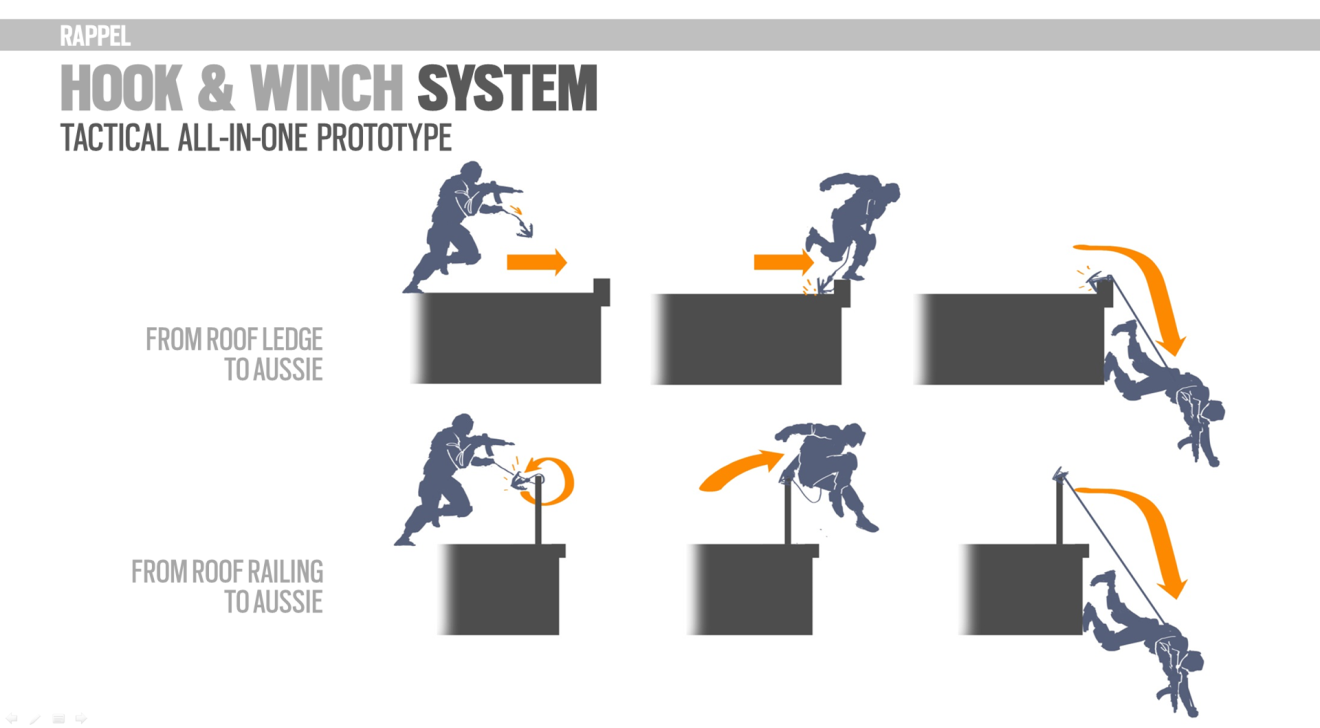
Rappelling from the top will immediately lead you to the aussie stance.
You'll be able to swing freely while rappelling, in addition to looking in and firing through any window (even in mid-swing). It opens up the options for attackers as they attempt to breach a stronghold.
Rappelling was something we felt was done well in previous Rainbow Six games, and we wanted to make it even better for Siege. As a player you should feel comfortable and have the movements be organic - even when you're doing something like setting a breach charge, pushing off the building to detonate, and then emptying your mag as you gracefully come into the building through the hole.
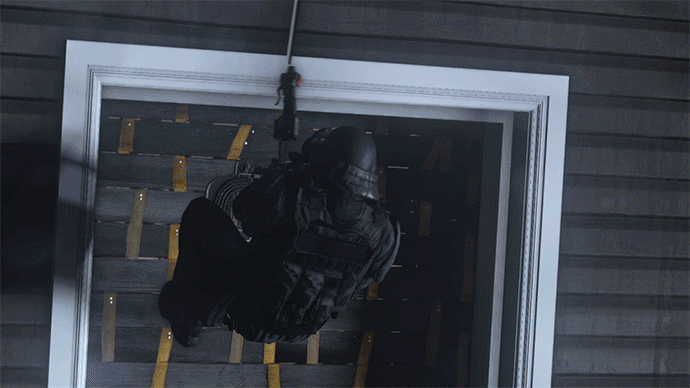
Rappelling and breaching can make for a very effective combo
Rappelling is a great tool for movement and surprise, but when it comes to the breach itself your bread and butter for will be breaching charges, which can be placed on any surface and detonated remotely. They can be used in a myriad of ways, including creating insertion points, distracting enemies, or even trapping them with a lethal breach.
With our RealBlast destruction engine, maps in Siege are designed to be moldable environments. This is where the breach charges come into play. They aren't deployed contextually, a classic game design method where you are prompted to place the charge when facing an intended placement location. Instead, you'll be able to place them anywhere you choose and destructibility will be based on the materials of the surface and other factors. With this we really want to enable creativity and open up your options when approaching any situation.
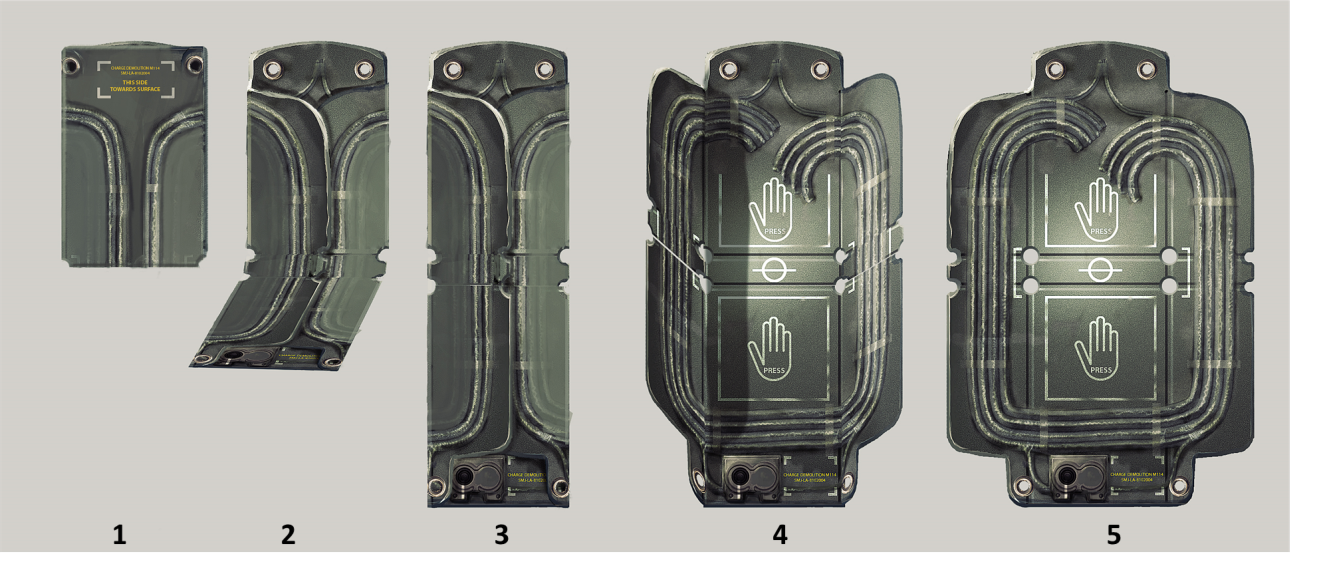
Breach charge deployment process.
Both attackers and defenders utilize destruction as part of their strategies, but the breach charge is reserved to the attacking team. Unlike other means of destruction, breach charges make a quick and clear path through walls, allowing for quick insertion to surprise the enemy.
In early prototypes breach charges were a sticky thing that you could throw on walls and floors, which was pretty convenient but not especially realistic. Now you actually need to be in contact with the wall or floor, and it takes a moment to deploy. In some situations it might be best to have a teammate cover for you while you set up the charge.
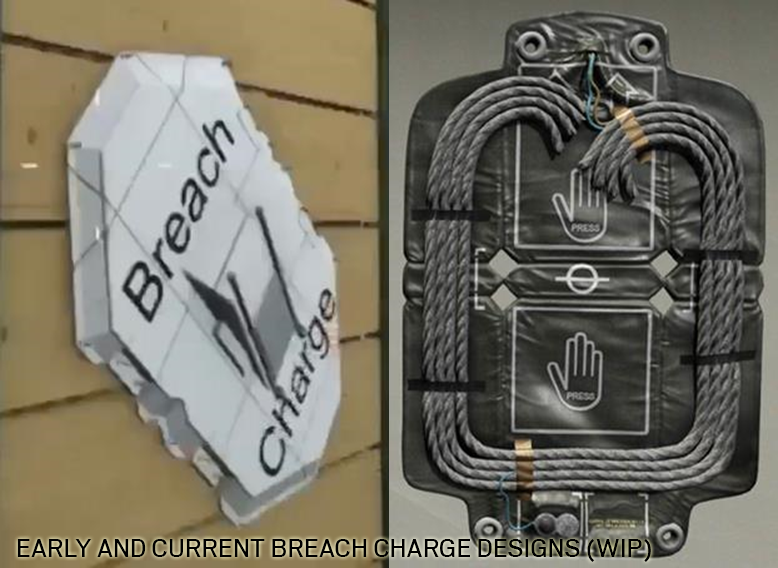
What the breach charge looked like in early prototypes, and what it looks like now.
Neutralizing the Threat
Now that you've found a way in, it's time to take out the enemy. No self-respecting CTU would head into an operation without bringing a few flash grenades (commonly referred to as 'flashbangs') along. Developed by the British SAS during the 1960s, they're non-lethal explosive devices used to temporarily disorient an enemy by creating a very loud "bang" and emitting a binding flash of light. One weakness of any attack strategy is that no matter where you enter, there's a chance that enemies might be waiting for you on the other side. Flashbangs can be just the trick to bridge that gap and give you an opportunity to capitalize on the brief confusion. We pay a lot of attention to things like physics so when you throw a flashbang against a wall, it will react appropriately. Even down to the animations, we really want all the tools you use to feel realistic, to immerse you in the fantasy, and flashbangs are no exception.
Another Rainbow Six staple you'll have at your disposal is the fragmentation grenade, an anti-personnel weapon that ejects shrapnel upon detonation. Ours are modeled after the classic M67 grenade and cannot be used to breach surfaces, since the danger lies in the shrapnel and not the explosion. Frag grenades come in handy for a variety of situations, but are especially nice to have when you're down in the team count and are facing several enemies. There is a cook timer on the grenades, and if enemies are bunched up you can quickly tighten the count with a good toss. But don't think that Rainbow Six Siege will be some kind of fragfest. CTUs traditionally do not carry frag grenades into operations, considering how dangerous they are in confined spaces. Still, we wanted to stay consistent with the history of the franchise, so they're available but in limited number. With high lethality (to the hostage as well as your teammates) and the close-quarters combat nature of the game, frag grenades will need to be used carefully as a tactical tool.
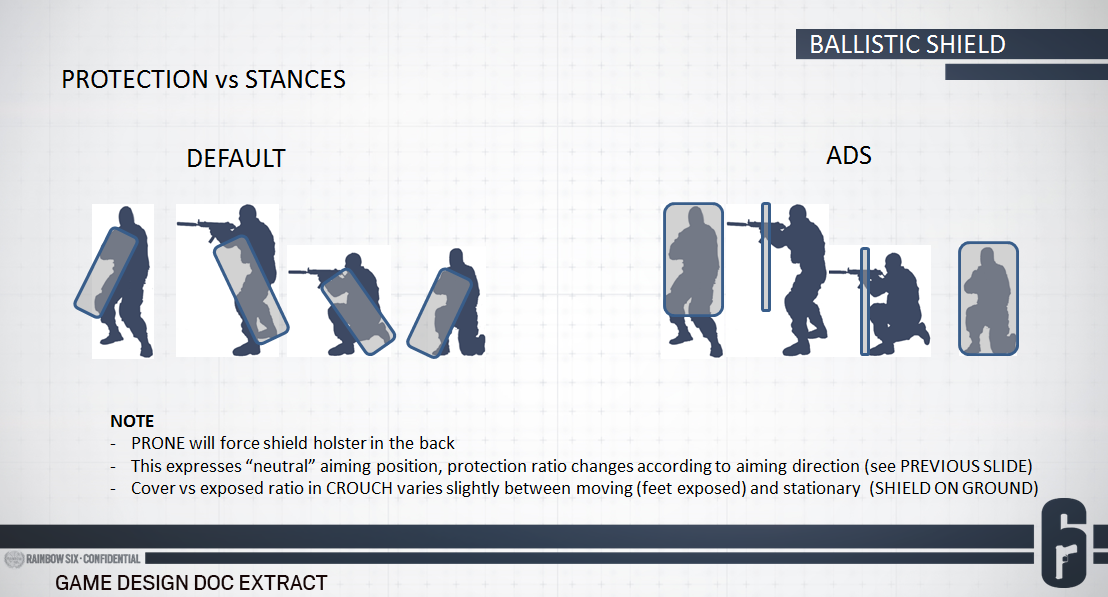
When skillfully used, the ballistic shield can be a powerful tool
Last but not least, the ballistic shield is a very strong active support tool that a point man will use to cover his teammates while they move together as a unit. The operator can only use a pistol while the ballistic shield is out, but he's much harder to kill and defenders will need to re-route themselves around him. Also in keeping with a realistic approach, the shield will slow your movement and it won't be entirely invincible so you'll need to take your time and act accordingly.
The tools described in this article are the basic tools of attack implemented thus far, and there may be more to share in the future. Stay tuned to blog next week when we publish our "Tools of Defense" article and find out what devices and mechanisms you'll have to defend your stronghold against the attackers. Until then…
- What combos or scenarios can you imagine using with the tools listed above?
- What other tools would you like to have available?
[](https://www.reddit.com/r/rainbow6)

Chase “Electr1cPanda” Straight - Community Developer, Ubisoft Montreal
Chase is a goofy American ex-pat living in Canada who loves music, DJing, blogging, and obviously gaming for hours. No discrimination here, Chase loves consoles as much as playing on his homebuilt gaming rig. Say hi and send cat pics (bonus points if they're wearing R6 gear) on Twitter at @R6ComDevs.

Genevieve "Livinpink" Forget - Community Developer, Ubisoft Montreal
Gen goes by the handle Livinpink in the gaming industry. She is known for her involvement in multiple competitive gaming communities through her work as eSports media and personality. She participates in weekly livestreamed Dungeons and Dragons sessions. She also tweets from @R6ComDevs.









